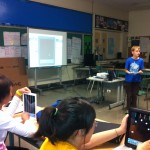A Miracle happened.
I ran the Toronto Marathon.
Why a miracle? I had already accepted that I had to back out of the race. Two weeks ago, during one of my long training runs, I suffered a pulled calf muscle. Three days ago, I woke up with a fever, sinus cold and cough. Regardless, I knew I had to try. I wanted to cross the line that said “Start”. Finishing didn’t matter.
I woke to thunder and lightning and pouring rain. As I sipped my coffee and ate my oatmeal, the rain slammed onto the course (which I could easily see from the hotel window). I wondered how wet my shoes and socks would get…how far I could go before the blisters started? My throat hurt, my spirits were down and I wasn’t’ sure at that point if I could do it.
Minutes before the gun went off, I received a text from a friend, “You don’t have to finish. It is everything you did to get to the starting line that is the accomplishment”. That was all I needed. I felt so proud of the dedicated hard work, and perseverance, over the last six months of training. My eyes teared as I crossed the starting line. I turned my iPod off and listened to the sounds of the crowd as they cheered the runners. I didn’t have anyone particular cheering me and yet, I found solace in those who made eye contact with me and gave me that encouraging glance. As I ran those first few kilometers, my mind drifted to a quote, recently shared with me by a friend (also a principal) , James Cowper, from his blog post called, “Why do I run? Because its hard.”
Long distance running is personal and political, but even more, it’s transcendental. You transcend “normal” behavior as well as your own expectations. Over time, this serial transcendence plateaus at a different idea of “normal.” Through this beautiful, empowering process, you locate and relocate your identity. You constantly create new conceptions of what’s possible and those new concepts become part of you. The key here is this: You then become more involved with the world as an agent of change. You rage a bit. And this entire process is modeled. Others witness it; many are moved by it—they change for the better. In this ongoing empowerment and transcendence, you are a public model, whether or not you think so. When you start running seventy miles a week, the people around you will eventually take notice and become curious. It’s an exceptional thing.
(James McWilliams — historian, activist — published on the blog, Myths About The Vegetarian Myth.)
This quote reminds me of what we discuss in learning and teaching. When we engage in anything – a project, a written work, a song, an art, a book, and we speak our thoughts and share our ideals- we empower others. When we write and share stories and interact with one another, we risk causing ripples of our ideals and maybe, just maybe, we might cause people to question, to ask, to wonder and to seek more – of themselves and of others. Maybe, our actions, whether it be the hours of training for a marathon or the hours of learning in schools make us catalysts for change, inspiring others to join our endeavor or create their own (whatever it may be).
 Running 42 Kilometers was a feat for me. Something that, while thousands of people do, I never imagined I could. I learned, that like anything we want to accomplish: with endurance, with practice, with an open mind, with drive and most importantly with support from others, we can overcome just about anything we want – even with our differences and deficits. More importantly, maybe our actions might inspire others.
Running 42 Kilometers was a feat for me. Something that, while thousands of people do, I never imagined I could. I learned, that like anything we want to accomplish: with endurance, with practice, with an open mind, with drive and most importantly with support from others, we can overcome just about anything we want – even with our differences and deficits. More importantly, maybe our actions might inspire others.
I thank my many friends, and colleagues for cheering me on virtually. My twitter stream was filled with comments of encouragement, support and inspiration from educators and learners across our Globe. Proudly, I crossed that finish line with my husband (@pipe72) waiting and cheering proudly.
Maybe it wasn’t really a miracle after all.

